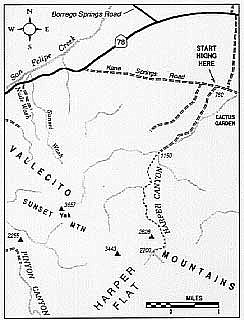 Facebook
Facebook
 X
X
 Instagram
Instagram
 TikTok
TikTok
 Youtube
Youtube
A long and leisurely ramble up the sinuous course of Harper Canyon in Anza-Borrego Desert State Park leads hikers to Harper Flat, a four-square-mile valley hidden from casual view by rock-strewn ridges and peaks. The reward for the trek, which takes about three hours for each direction, is the sense of splendid isolation you get all along the way, and at the destination itself.
Barrel cactus
You'll need an Anza-Borrego parking pass before starting this or any other off-road trek within the state park. Call 760-767-4205 or 760-767-5311 for more information. To get to where you can start hiking, drive east on Highway 78 to a dirt road intersecting at mile 87.2. Go 1.6 miles south to a T-intersection with the old Kane Springs Road. Turn right, drive 0.2 mile west, then veer left on a dirt road trending southwest. Park there, or drive farther on if your vehicle allows.
The road skirts an area known as the Cactus Garden, where barrel cacti, especially, grow thick and as tall as seven feet. When the roadbed ends, the walls of Harper Canyon narrow, then widen again as tributary canyons split off on both sides. A better name for the canyon would perhaps be "Ironwood Canyon." You'll pass hundreds of these slow-growing, dense-limbed trees in the next three miles. These will offer at least semi-shade if the day is warm and sunny.
After some intermittent, easy scrambles over rock dikes or ledges, you'll begin to see smoke trees and desert-willows, with foliage even less substantial than that of the ironwoods. Then, at 4.5 miles from Kane Springs Road, you'll come upon the broad expanse of Harper Flat. Curiously, Harper Canyon drains most but not all of Harper Flat. The flat more closely resembles an elevated plateau than a river valley.
Soak in the silence -- or if the spirit moves you, scramble up the ridge to the north about 400 vertical feet to a small promontory at 2628 feet elevation. There you get a superb view of the smooth expanse of Harper Flat and various landmarks to the north, including the Santa Rosa Mountains and the Salton Sea.


A long and leisurely ramble up the sinuous course of Harper Canyon in Anza-Borrego Desert State Park leads hikers to Harper Flat, a four-square-mile valley hidden from casual view by rock-strewn ridges and peaks. The reward for the trek, which takes about three hours for each direction, is the sense of splendid isolation you get all along the way, and at the destination itself.
Barrel cactus
You'll need an Anza-Borrego parking pass before starting this or any other off-road trek within the state park. Call 760-767-4205 or 760-767-5311 for more information. To get to where you can start hiking, drive east on Highway 78 to a dirt road intersecting at mile 87.2. Go 1.6 miles south to a T-intersection with the old Kane Springs Road. Turn right, drive 0.2 mile west, then veer left on a dirt road trending southwest. Park there, or drive farther on if your vehicle allows.
The road skirts an area known as the Cactus Garden, where barrel cacti, especially, grow thick and as tall as seven feet. When the roadbed ends, the walls of Harper Canyon narrow, then widen again as tributary canyons split off on both sides. A better name for the canyon would perhaps be "Ironwood Canyon." You'll pass hundreds of these slow-growing, dense-limbed trees in the next three miles. These will offer at least semi-shade if the day is warm and sunny.
After some intermittent, easy scrambles over rock dikes or ledges, you'll begin to see smoke trees and desert-willows, with foliage even less substantial than that of the ironwoods. Then, at 4.5 miles from Kane Springs Road, you'll come upon the broad expanse of Harper Flat. Curiously, Harper Canyon drains most but not all of Harper Flat. The flat more closely resembles an elevated plateau than a river valley.
Soak in the silence -- or if the spirit moves you, scramble up the ridge to the north about 400 vertical feet to a small promontory at 2628 feet elevation. There you get a superb view of the smooth expanse of Harper Flat and various landmarks to the north, including the Santa Rosa Mountains and the Salton Sea.
